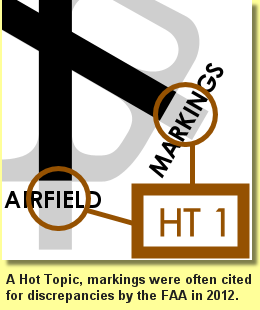 |
 |
2012 FAA Safety InspectionsBy Mike Speidel
In review, 2012 saw more airports being "knicked" on their pavement markings during certification inspections. In fact, it was often the first time the subject airports had ever been written up for markings, much to their surprise. These discrepancies weren't always written up in the traditional, "Markings are faded", way either. For example, multiple FAA Airport Certification Safety Inspectors required airports to remediate certain markings for having "excessive thickness" and "low reflectivity". Incidentally, both of those qualities are currently undefined by the FAA AC 150/5340-1K. Airport folks, close your eyes... This is a good thing. Airfield markings deemed non-compliant based on qualities that do not currently exist in FAA guidance literature is frusterating for airport stakeholders. The fact is, there is no definitive guidance regarding how thick or how reflective a marking can or should be before it becomes non-compliant. As aforementioned, those maintenance criteria, among others, have yet to be defined by the FAA. However, that's not to suggest the Inspectors aren't correct to identify marginal marking qualities as safety issues; in fact I encourage it. Still, an argument can be made from the subjectivity with which the discrepancies are explained. Further, in some cases, the required remediations to markings were accompanied by mandatory completion deadlines established by the FAA. In several instances, airports didn't have the time or the tools required to do the work. As a result, airports often had little choice other than to expedite contractor rehabilition projects in reaction to the imposed deadlines, despite the big price tags associated with them. Ultimately, the industry spent millions in 2012 rehabbing markings to satisfy FAA requirements whereas the Sightline strategy would have identified issues before they became problems for a tiny fraction of the cost of rehab. We're helping several of these airports sort out how they arrived at the point of marking rehab, and most importantly, developing methods to achieve an effective, sustainable marking system so they won't end up in the same predicament going forward. Markings are as hot a topic as ever as they relate to safety. The subjective scrutiny associated with them may be here to stay for the foreseeable future, but that doesn't mean you should wait for an FAA Inspector to write up your airport. What you want is a comprehensive and objective evaluation of your marking system that will identify where and why markings need maintenance and what methods to use, all on your own terms and timeline. For more on that, download a one-page PDF about the Airfield Marking Audit. |

 Airport pavement markings have been a hot topic in the recent years receiving a lot of attention and scrutiny in the
process. Generally, airports have challenges with markings whether they know it or not. The reasons for these challenges are several, and
FAA safety inspectors raised the bar last year citing specific marking deficiencies and requiring prompt resolution.
Airport pavement markings have been a hot topic in the recent years receiving a lot of attention and scrutiny in the
process. Generally, airports have challenges with markings whether they know it or not. The reasons for these challenges are several, and
FAA safety inspectors raised the bar last year citing specific marking deficiencies and requiring prompt resolution.